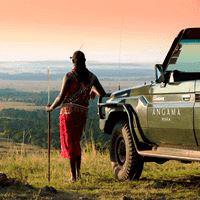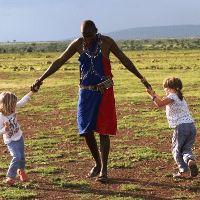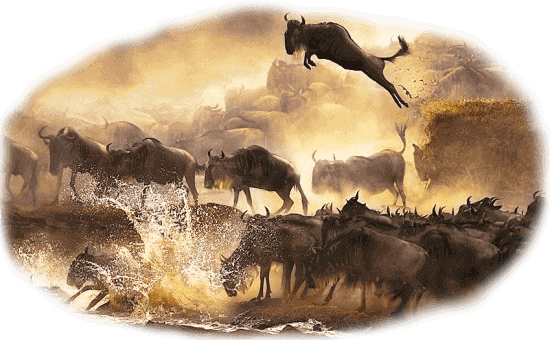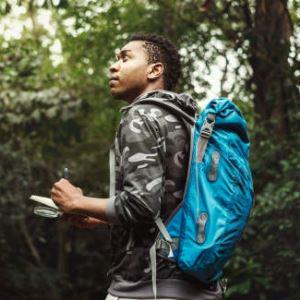 Embarking on a Kenyan safari is a captivating adventure that immerses travelers in the breathtaking beauty of the African wilderness. At HomeJoy Safari Adventures, we will help you see beyond the thrill of spotting majestic wildlife and diverse landscapes, as there is an opportunity to delve deeper into the rich cultural heritage of Kenya. One such enriching experience is a visit to the traditional Maasai villages, where time seems to stand still and ancient traditions come to life. The Maasai people, known for their vibrant red attire and remarkable nomadic lifestyle, have inhabited Kenya and Tanzania for centuries. Nestled amidst the vast savannahs and rolling hills of Kenya, their villages provide a fascinating glimpse into a way of life that has endured through generations. A visit to a Maasai village offers an authentic and immersive encounter with a resilient and proud community. As you step into the village, you will be greeted by friendly faces and warm smiles, as the Maasai people extend their legendary hospitality. Immerse yourself in their traditional dances and melodious songs, accompanied by rhythmic chants and the distinctive beat of drums. Engage with the villagers, and through their stories, gain a profound understanding of their customs, rituals, and the challenges they face in preserving their cultural heritage in a rapidly changing world. Explore the intricate craftsmanship of Maasai artisans, marveling at the intricate beadwork and leatherwork that adorns their clothing and jewelry. Learn about their unique architectural style, characterized by sturdy mud-and-dung huts adorned with vibrant paintings. Gain insights into their traditional farming practices, animal husbandry, and the intricate social structure that governs their society. A visit to a traditional Maasai village is not only a chance to witness a captivating culture but also an opportunity to support sustainable tourism initiatives that benefit local communities. If you engage with the Maasai people and support their handicrafts, you contribute to the preservation of their heritage and empower them to thrive in the modern world. Exploring the traditional Maasai villages while on a Kenyan safari promises an unforgettable encounter with a resilient and vibrant community. By immersing yourself in their customs, stories, and craftsmanship, you will not only gain a deeper appreciation for their way of life but also contribute to the preservation of their rich cultural heritage. So, venture beyond the wildlife and landscapes, and embark on a journey of cultural discovery that will leave an indelible mark on your heart and soul.
Embarking on a Kenyan safari is a captivating adventure that immerses travelers in the breathtaking beauty of the African wilderness. At HomeJoy Safari Adventures, we will help you see beyond the thrill of spotting majestic wildlife and diverse landscapes, as there is an opportunity to delve deeper into the rich cultural heritage of Kenya. One such enriching experience is a visit to the traditional Maasai villages, where time seems to stand still and ancient traditions come to life. The Maasai people, known for their vibrant red attire and remarkable nomadic lifestyle, have inhabited Kenya and Tanzania for centuries. Nestled amidst the vast savannahs and rolling hills of Kenya, their villages provide a fascinating glimpse into a way of life that has endured through generations. A visit to a Maasai village offers an authentic and immersive encounter with a resilient and proud community. As you step into the village, you will be greeted by friendly faces and warm smiles, as the Maasai people extend their legendary hospitality. Immerse yourself in their traditional dances and melodious songs, accompanied by rhythmic chants and the distinctive beat of drums. Engage with the villagers, and through their stories, gain a profound understanding of their customs, rituals, and the challenges they face in preserving their cultural heritage in a rapidly changing world. Explore the intricate craftsmanship of Maasai artisans, marveling at the intricate beadwork and leatherwork that adorns their clothing and jewelry. Learn about their unique architectural style, characterized by sturdy mud-and-dung huts adorned with vibrant paintings. Gain insights into their traditional farming practices, animal husbandry, and the intricate social structure that governs their society. A visit to a traditional Maasai village is not only a chance to witness a captivating culture but also an opportunity to support sustainable tourism initiatives that benefit local communities. If you engage with the Maasai people and support their handicrafts, you contribute to the preservation of their heritage and empower them to thrive in the modern world. Exploring the traditional Maasai villages while on a Kenyan safari promises an unforgettable encounter with a resilient and vibrant community. By immersing yourself in their customs, stories, and craftsmanship, you will not only gain a deeper appreciation for their way of life but also contribute to the preservation of their rich cultural heritage. So, venture beyond the wildlife and landscapes, and embark on a journey of cultural discovery that will leave an indelible mark on your heart and soul.
What are the Maasai villages called?
The Maasai villages are commonly known as "manyattas." These traditional settlements are typically made up of a collection of huts or bomas constructed from locally available materials such as mud, sticks, grass, and cow dung.
Where do the Maasai people traditionally live?
The Maasai people are indigenous to East Africa, particularly Kenya and Tanzania. In Kenya, they are primarily concentrated in the southern part of the country, mainly in the Rift Valley region and Maasai Mara National Reserve. Traditionally, the Maasai are semi-nomadic pastoralists, moving their herds of cattle across vast open grasslands.
What are the 5 features of Maasai villages?
Maasai villages possess distinct characteristics that reflect their traditional way of life and cultural practices. Here are five notable features of Maasai villages:
- Boma: The central structure in a Maasai village is the boma, which serves as a protective enclosure for the community. It is typically constructed in a circular shape using thorny acacia branches to deter wild animals and potential threats.
- Manyatta huts: The manyatta huts, or inkajijik, are the dwellings of the Maasai people. These huts are constructed by the women using a framework of wooden poles covered with a mixture of mud, cow dung, and grass. Each hut is typically assigned for a specific purpose, such as sleeping, cooking, or storage.
- Cattle enclosure: As cattle play a vital role in Maasai culture, a separate enclosure within the boma is designated to safeguard the herds during the night. This enclosure ensures the protection of the cattle from predators and theft.
- Cultural artifacts: Maasai villages often display various cultural artifacts that provide insights into their rich heritage. These artifacts can include traditional beadwork, distinctive Maasai weaponry like spears and shields, and colorful clothing adorned with intricate bead patterns.
- Open communal spaces: Manyattas are designed with open communal spaces where important social gatherings, discussions, and ceremonies take place. These areas serve as the heart of the village, fostering community bonds and facilitating cultural practices.
What are the reasons why tourists visit Maasai villages?
Visiting Maasai villages has become a popular activity for tourists on Kenyan safaris due to the unique cultural experience it offers. Here are six reasons why tourists are drawn to Maasai villages:
- Cultural immersion: Tourists have the opportunity to engage with the Maasai people and gain firsthand insights into their age-old traditions, customs, and way of life. This immersive experience allows visitors to appreciate and learn about the Maasai culture.
- Traditional dances and rituals: Maasai villages often organize vibrant cultural performances, including traditional dances, singing, and rituals. Tourists can witness these captivating displays of Maasai music and dance, which are an integral part of their social and ceremonial activities.
- Crafts and beadwork: Maasai artisans are renowned for their intricate beadwork and craftsmanship. Tourists can purchase authentic Maasai handicrafts, including beaded jewelry, wooden carvings, and vibrant textiles, directly from the skilled artisans themselves.
- Homestays and hospitality: Some Maasai villages offer homestay programs, allowing tourists to stay with Maasai families and experience their everyday life firsthand. This provides a unique opportunity to forge meaningful connections, share meals, and understand the daily routines of the Maasai people.
- Educational experiences: Tourists interested in cultural anthropology or African history find Maasai villages to be valuable educational experiences. By interacting with the Maasai people, visitors can deepen their understanding of indigenous African cultures and gain a broader perspective on the world.
- Sustainable tourism support: By visiting Maasai villages, tourists contribute to the local economy and support sustainable tourism initiatives. The revenue generated from tourism activities helps preserve the Maasai culture, support community development projects, and create employment opportunities for the local population.
Embarking on a Kenyan safari and visiting traditional Maasai villages is an unforgettable experience that offers a unique glimpse into the rich cultural heritage of the Maasai people. Beyond the breathtaking wildlife encounters, these villages provide an opportunity to engage with a vibrant community and immerse oneself in their time-honored traditions. By visiting a Maasai village, travelers can witness firsthand the resilience and adaptability of people who have maintained their traditional way of life in the face of modernization. From the distinctive clothing and intricate beadwork to the rhythmic chants and spirited dances, every aspect of Maasai culture tells a captivating story. Moreover, these visits foster meaningful connections between visitors and the Maasai people, promoting cultural exchange and understanding. By engaging in conversations, participating in daily activities, and even staying overnight in a traditional hut, travelers gain a profound appreciation for the values, customs, and challenges faced by the Maasai community. As we venture into the future, preserving and celebrating indigenous cultures like that of the Maasai becomes increasingly important. Through responsible tourism and respectful engagement, we can ensure the conservation of their traditions and support their sustainable development. So, let the call of the wild guide you to the enchanting Maasai villages, where ancient traditions and untamed beauty intertwine, leaving an indelible mark on your heart and soul.
Why are Loita Plains Best for Pastoral Grazing Among Maasai Villages?
 The Loita Plains, nestled within the enchanting landscapes of Kenya, has long been revered as the epitome of pastoral grazing among Maasai villages. Renowned for their unparalleled beauty and remarkable ecological diversity, these plains possess a myriad of qualities that make them the ultimate choice for the Maasai people and their treasured herds of livestock. First and foremost, the Loita Plains offers an abundant and varied food source for grazing animals. Stretching across vast expanses, these grassy plains boast lush vegetation, providing an ample supply of nutrient-rich grasses throughout the year. This natural abundance ensures that the Maasai livestock, primarily consisting of cattle, sheep, and goats, can feed on a diverse range of forage, promoting their optimal growth and well-being. Additionally, the Loita Plains are characterized by a favorable climate, which further enhances their suitability for pastoral grazing. The region experiences a moderate and consistent rainfall pattern, offering a reliable water supply for both livestock and the vegetation they depend on. The ample rainfall ensures the continuous growth of the grasslands, preventing them from drying up and ensuring a constant supply of fresh grazing land for the Maasai herds. Furthermore, the Loita Plains harbor a harmonious ecosystem that supports the interdependence between the Maasai and their livestock. The Maasai people have long-standing traditions and practices deeply rooted in sustainable grazing techniques. They carefully manage the grazing patterns and movements of their livestock, allowing the vegetation to regenerate and preventing overgrazing. This symbiotic relationship between the Maasai and the land ensures the preservation and longevity of the Loita Plains' resources. The Loita Plains stands as a shining example of the perfect environment for pastoral grazing among the Maasai villages. The abundant food supply, favorable climate, and harmonious relationship between the Maasai people and their livestock all contribute to the plains' exceptional suitability for sustaining the traditional way of life and ensuring the prosperity of the Maasai people for generations to come.
The Loita Plains, nestled within the enchanting landscapes of Kenya, has long been revered as the epitome of pastoral grazing among Maasai villages. Renowned for their unparalleled beauty and remarkable ecological diversity, these plains possess a myriad of qualities that make them the ultimate choice for the Maasai people and their treasured herds of livestock. First and foremost, the Loita Plains offers an abundant and varied food source for grazing animals. Stretching across vast expanses, these grassy plains boast lush vegetation, providing an ample supply of nutrient-rich grasses throughout the year. This natural abundance ensures that the Maasai livestock, primarily consisting of cattle, sheep, and goats, can feed on a diverse range of forage, promoting their optimal growth and well-being. Additionally, the Loita Plains are characterized by a favorable climate, which further enhances their suitability for pastoral grazing. The region experiences a moderate and consistent rainfall pattern, offering a reliable water supply for both livestock and the vegetation they depend on. The ample rainfall ensures the continuous growth of the grasslands, preventing them from drying up and ensuring a constant supply of fresh grazing land for the Maasai herds. Furthermore, the Loita Plains harbor a harmonious ecosystem that supports the interdependence between the Maasai and their livestock. The Maasai people have long-standing traditions and practices deeply rooted in sustainable grazing techniques. They carefully manage the grazing patterns and movements of their livestock, allowing the vegetation to regenerate and preventing overgrazing. This symbiotic relationship between the Maasai and the land ensures the preservation and longevity of the Loita Plains' resources. The Loita Plains stands as a shining example of the perfect environment for pastoral grazing among the Maasai villages. The abundant food supply, favorable climate, and harmonious relationship between the Maasai people and their livestock all contribute to the plains' exceptional suitability for sustaining the traditional way of life and ensuring the prosperity of the Maasai people for generations to come.
Where are the Maasai pastoralists mainly found in Kenya?
The Maasai pastoralists predominantly inhabit southern Kenya and northern Tanzania. In Kenya, they primarily reside in the Rift Valley, including areas such as Kajiado, Narok, and parts of Laikipia and Samburu counties. They account for 36 percent of the total population which is around 14 million people
What are the 5 things that characterize pastoral grazing?
Pastoral grazing among the Maasai is characterized by the following elements:
- Mobility: Maasai pastoralists are known for their nomadic lifestyle, constantly moving their herds to access fresh pastures and water sources. This mobility allows the land to regenerate while preventing overgrazing.
- Livestock Dependence: Cattle, sheep, and goats form the primary livestock for the Maasai. They depend on these animals for food, milk, clothing, and as a symbol of wealth and status within their society.
- Communal Grazing: Pastoral grazing is typically communal, with Maasai villages sharing grazing lands known as "shambas." These shambas are managed collectively, enabling fair distribution of resources and fostering social cohesion within the community.
- Traditional Knowledge: Maasai pastoralists possess a wealth of traditional knowledge about livestock management, including identifying suitable grazing areas, understanding animal behavior, and utilizing herbal remedies for livestock healthcare.
- Resilience: Pastoral grazing requires the Maasai to adapt to harsh environmental conditions, such as droughts or unpredictable weather patterns. Their resilience and ability to cope with such challenges contribute to their success as pastoralists.
What are the factors that favor pastoral grazing in Kenya?
Several factors contribute to the suitability of Kenya for pastoral grazing:
- Abundance of Grasslands: Kenya boasts vast grassland ecosystems, which provide ample grazing areas for livestock. The nutrient-rich grasses support the growth and sustenance of Maasai herds.
- Diverse Ecological Zones: The country's varied ecological zones, including highlands, lowlands, and semi-arid regions, offer different grazing opportunities throughout the year. This diversity allows the Maasai to move their herds in search of favorable conditions.
- Natural Water Sources: Kenya is blessed with numerous rivers, lakes, and natural water bodies. These water sources are essential for sustaining livestock during dry seasons and ensuring their overall well-being.
- Land Tenure Systems: The Maasai's customary land tenure systems, such as communal land ownership, allow for the establishment of grazing areas and ensure equitable access to resources within the community.
- Biodiversity: Kenya's biodiversity, including the presence of wildlife in some grazing areas, contributes to the overall health of the ecosystems. The coexistence of livestock and wildlife supports the ecological balance and sustains the pastoral system.
- Traditional Institutions: Maasai communities have well-established traditional institutions and governance systems that regulate access to grazing lands and resolve conflicts. These institutions play a crucial role in maintaining harmony and sustainability within pastoral communities.
Which are the reasons why the Maasai keep large herds of cattle?
The Maasai place great importance on cattle, and here are five reasons for keeping large herds:
- Wealth and Status: Cattle are a symbol of wealth and social status among the Maasai. The larger the herd, the higher the social standing and prestige within the community.
- Subsistence: Cattle provide essential resources for the Maasai's subsistence, including milk, meat, blood, and hides. These products form the foundation of their diet and livelihood.
- Bride Wealth: In Maasai culture, cattle play a significant role in marriage negotiations. The groom's family presents cattle to the bride's family as a form of dowry, strengthening family ties and ensuring the continuation of the lineage.
- Rituals and Ceremonies: Cattle are central to many Maasai rituals and ceremonies, such as initiation rites, coming-of-age celebrations, and religious ceremonies. They hold deep cultural and spiritual significance for the community.
- Investment and Security: Large herds of cattle serve as an investment for the Maasai. They can be sold or traded during times of need, such as drought or economic hardships, providing a source of income and ensuring the community's security.
Pastoralism is an essential way of life for the Maasai people in Kenya. The Maasai are renowned for their traditional cattle-herding practices, which have been passed down through generations. Among the various regions in Kenya where the Maasai reside, the Loita Plains stands out as one of the most favorable areas for pastoral grazing. The Loita Plains, among the various regions where the Maasai reside, offer favorable conditions for pastoral grazing. The Maasai's traditional way of life, characterized by mobility, communal grazing, and their deep connection to cattle, has been sustained by the availability of grasslands, water sources, and diverse ecological zones in Kenya. The Maasai's reliance on large herds of cattle reflects their cultural, social, and economic values. Understanding the factors that contribute to the success of pastoral grazing among the Maasai sheds light on the importance of preserving their unique way of life and the ecosystems they depend on.






